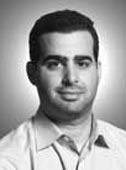RESIDENTS' CORNER: Neuroethics and the Haunted History of Psychosurgery

Nir Lipsman
|
Nir Lipsman spent a summer
working with Andres
Lozano in 2005, the year
that the first paper on Deep
Brain Stimulation (DBS) for
depression was published. He
has been collaborating with
Andres, neurologists, and psychiatrists
ever since, focusing
on the mind - body relationship
and applying novel neurosurgical
tools to psychiatric
populations. Nir completed undergraduate training in
Psychology at the University of Toronto and medical
school at Queen's University in Kingston. He is currently
a 4th year neurosurgery resident, in his first year of a
neuroscience PhD in the Clinician Investigator Program.
His thesis will be focused on using deep brain stimulation,
and single neuron recordings to probe emotional
reward and decision making circuitry. Courses for his
PhD program include the schizophrenia seminar, genetics,
epidemiology, neuroanatomy and research ethics.
Surgeon - ethicist Mark Bernstein sparked Nir's interest
in neuroethics, a subset of biomedical ethics that
looks at ethical challenges in the neurosciences. Typical
neuroethics topics include consent and patient selection
for deep brain stimulation, balancing the risks and gains
of stimulation and clinical trials of DBS. Neuroscience
merges with philosophy when research examines the impact
of deep brain stimulation on concepts of free will,
choice and a wide range of psychological effects. This
rapidly expanding field is generating knowledge, has developed
journals (Neuroethics, American Journal of Bioethics:
Neuroscience) and has developed a society (Neuroethics
Society: www.neuroethicssociety.org)
Nir described 'the haunted history of psychosurgery' and
the renaissance of interest in the field over the past several
years. In the 1950s and 60s, over 40.000 lobotomies were
|
performed, leaving psychosurgery with a bad reputation.
Currently, however, we are well past the lobotomy era with
safe and effective procedures under investigation to treat the
many patients with resistant mental illness. Up to 30% of
psychiatric patients get no benefit from current treatment.
Another neurosurgical operation, temporal lobectomy,
works for many patients with epilepsy, but few are offered
this treatment because of fear and lack of knowledge.Will
deep brain stimulation for depression go the same way as
temporal lobectomy? Nir hopes to prevent this misinterpretation
and misuse of a valuable intervention through scholarly
examination, research and practice.
One day Nir was in the operating room with a patient
who was receiving deep brain stimulation for depression
following failure of electro-convulsive therapy.
The patient, who had been bed- bound for years, said
that all the colours got brighter when the stimulator
was on. She described it as "a lightening". The stimulator
was nowhere near the optic nerves or the optic areas
of the brain. The lightening or brightening was "like a
change of glasses" and has been experienced by patients
in other centres. Afterward, the patient said: "I'd like to
go clean my house". She and others have also developed
this "clean my garage...take care of myself or my home"
- grooming behaviour. This opens up a new avenue of
research on motivation and reward through DBS.
As Andres Lozano pioneers this field, there is a danger
that others might want to move too fast, as Christian
Bernard did - taking his specialty into cardiac transplantation
prematurely. "The appropriate approach should
be the development of registries instead of single case
reports and single surgeon adventures. Currently psychosurgery
is more focused, minimally invasive, hypothesis
driven and generally reversible. It is based on genetics,
imaging, and performance in the scientific setting. Public
education is an important task given the haunted history
of the specialty."
Nir was born in Israel; moved to Toronto at age 6. He
is married to Sarit Marko, a professional artist.
M.M.
|